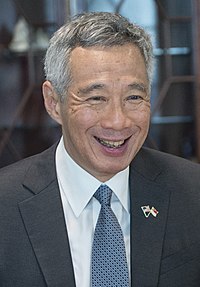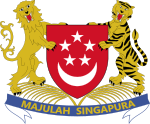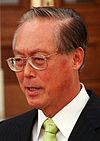Prime Minister of Singapore
| Prime Minister of the Republic of Singapore | |
|---|---|
| Perdana Menteri Republik Singapura 新加坡共和国总理 சிங்கப்பூர் குடியரசின் பிரதமர் | |
 Lee Hsien Loong since 12 August 2004 | |
| Government of Singapore Cabinet of Singapore Prime Minister's Office | |
| Style | Mr Prime Minister (informal) The Honourable (formal) His Excellency (diplomatic) |
| Type | Head of government |
| Abbreviation | PM |
| Residence | Sri Temasek |
| Appointer | President |
| Term length | No term limit |
| Inaugural holder | Lee Kuan Yew |
| Formation | 3 June 1959 |
| Deputy | Deputy Prime Minister |
| Salary | S$2,200,000 annually (including S$192,500 MP salary) |
| Website | www |
Politics of Singapore |
|---|
 |
|
The prime minister of Singapore is the head of government of the Republic of Singapore. The president appoints the prime minister, a Member of Parliament (MP) who, in their opinion, is most likely to command the confidence of the majority of MPs. In practice, the prime minister has been the leader of the political party with the largest amount of elected MPs in the Parliament of Singapore. The incumbent prime minister is Lee Hsien Loong, who is the secretary-general of the People's Action Party.
History[]
The office of prime minister succeeded the chief minister's post after Singapore achieved internal self-governance as the State of Singapore within the British Empire,[1][2] with Lee Kuan Yew being sworn in as the first prime minister on 5 June 1959.[3] The title of prime minister remained unchanged after Singapore's merger with Malaya, Sarawak and North Borneo to form Malaysia from 1963 to 1965, despite the existence of the prime minister of Malaysia for the entire federation of which Singapore was part of.[4][5]
Following independence in 1965, the office of prime minister was retained, with the presidency becoming a ceremonial head of state. In 1991, amendments to the Constitution of Singapore vested executive powers in the presidency, along with discretionary veto powers over the government.[6] The Constitution also vests "general direction and control of the government" in the Cabinet, with the president almost always bound to act on the advice of the Cabinet or any minister acting under Cabinet authority. Thus, in practice, most of the actual work of governing is done by the prime minister and Cabinet.[7]
Resources[]
The Istana is the working office of the prime minister.[8] The prime minister is protected by the Specialised Security Command of the Singapore Police Force, who also ensure the protection of the president, the other Cabinet ministers, and visiting foreign dignitaries.[9]
Powers[]
The prime minister is responsible for overseeing the overall day-to-day affairs of the government and executing government policy. As leader of the majority party in Parliament, the prime minister is responsible for passing legislation through Parliament. The prime minister also nominates the speaker of parliament and leader of the house, who are responsible for arranging government business and organising legislative programmes, usually under the directive of the prime minister and the Cabinet.[10]
The prime minister chooses the other members of the Cabinet by advising the president; the president must exercise his or her powers in accordance with the advice of the prime minister. The prime minister may change, retain, or revoke any sitting minister's appointment under their prerogative.[11] The prime minister also advises the president on appointments for the office of attorney-general and permanent secretaries to the ministries.[12][13]
The prime minister can advise the president for a Proclamation of Emergency; the president issues the proclamation if satisfied.[14] The prime minister can declare a defence or security measure,[15] and has executive authority over the Singapore Armed Forces through the Armed Forces Council, which consists of the minister for defence, permanent secretaries of the Ministry of Defence, and service chiefs; all of whom are appointed by the president under the prime minister's advice.[16]
Allowance[]
The prime minister receives an annual total salary package (inclusive of 13th month bonus, Annual Variable Component and National Bonus) that is twice the MR4 benchmark, or S$2.2 million. As there is no one to decide on the annual performance bonus for the PM, the PM's bonus will be based only on the National Bonus.[17] The prime minister is also on the Medisave-cum-Subsidised Outpatient (MSO) scheme.[18]
The prime minister's annual salary was S$3.07 million before a salary review in 2011.[19] On 21 May 2011, a committee was appointed by the prime minister to review the salaries of the prime minister as well as the president, political appointment holders, and members of Parliament.[20] After the recommended wage reductions by the committee were accepted in Parliament, the prime minister's salary was reduced by 36% (including the removal of his pension) to S$2.2 million (approximately US$1.7 million at the time).[19] Nonetheless, the prime minister of Singapore remains the highest-paid political leader in the world.[21]
List of prime ministers[]
| No. | Portrait | Name (birth and death) Constituency |
Election | Term of office | Political Party | |||
|---|---|---|---|---|---|---|---|---|
| Took office | Left office | Time in office | ||||||
| 1 | 
|
Lee Kuan Yew 李光耀 லீ குவான் இயூ (1923–2015) MP for Tanjong Pagar SMC, 1955-1991 MP for Tanjong Pagar GRC, 1991–2015 |
1959, 1963, 1968, 1972, 1976, 1980, 1984, 1988 | 5 June 1959 | 28 November 1990 | 31 years, 178 days | ||
| The first prime minister of Singapore. He is the longest-serving prime minister of Singapore. His tenure led to the expansion of Singapore's economy from a British Crown Colony into a first world country. He introduced the National Service (NS) scheme, with the help of his defence minister Goh Keng Swee. He introduced the Stop-At-Two child policy in 1960s, for fearing of over expansion of Singapore population. In the 1980s, he introduced the Graduate Mother Scheme to counter the effects of the previous policy, which received a huge backlash. The policy was withdrawn shortly thereafter. He led the PAP into 8 consecutive election victories. During his tenure, Singapore grew to become the most prosperous nation in South-east Asia.[22] | ||||||||
| 2 | 
|
Goh Chok Tong 吴作栋 கோ சொக் தொங் (b. 1941) MP for Marine Parade SMC, 1976-1988 MP for Marine Parade GRC, 1988–2020 |
1991, 1997, 2001 | 28 November 1990 | 12 August 2004 | 13 years, 258 days | ||
| The second prime minister of Singapore. He introduced several major policies and policy institutions, such as Medisave, Non-constituency members of Parliament, Government Parliamentary Committees, Group Representation Constituencies, Nominated Members of Parliament, the Vehicle Quota Scheme, the direct election of the president and Singapore 21. During his tenure Singapore experienced several crises, such as the 1997 Asian financial crisis, threats of terrorism including the 2001 Singapore embassies attack plot by Jemaah Islamiyah, the 2001–2003 economic recession, and the 2003 SARS outbreak. He also introduced the Baby Bonus scheme in a bid to increase birth rates. Prior his appointment as PM, he served as Senior Minister of State for Finance, Minister for Trade and Industry, Minister for Health, Minister for Defence and first deputy prime minister.[23] | ||||||||
| 3 | 
|
Lee Hsien Loong 李显龙 லீ சியன் லூங் (b. 1952) MP for Teck Ghee SMC, 1984-1991 MP for Ang Mo Kio GRC, 1991–present |
2006, 2011, 2015, 2020 | 12 August 2004 | Incumbent | 17 years, 138 days | ||
| The third prime minister of Singapore and the son of Lee Kuan Yew, the first prime minister. He introduced the five-day working week for civil servants, with the hope of increasing the birth rate. One of his major accomplishments was to propose the building of 2 Integrated Resorts (IR) in Singapore. Singapore hosted the inaugural summer Youth Olympic Games in 2010. He promoted the abolition of school ranking. In 2013, he presided over the worst haze crisis in Singapore’s history. He has also dealt with the 2013 Dengue epidemic and the COVID-19 pandemic since 2020. Prior to his Prime Ministership, he served as the Deputy Prime Minister (1991–2004), Minister for Finance, and as the Minister for Trade and Industry. | ||||||||
See also[]
- Cabinet of Singapore
- Politics of Singapore
- Prime Minister's Office (Singapore)
- Leader of the Opposition
References[]
- ^ Hoe Yeen Nie (2 June 2009). "State of Singapore came into being 50 years ago on 3 June". Channel NewsAsia. Archived from the original on 8 July 2009. Retrieved 3 June 2009.
- ^ "Statesmen keep an old date". Singapore Free Press. 18 November 1959. Retrieved 20 April 2021.
- ^ "The Cabinet to be sworn in today". The Straits Times. 5 June 1959. Retrieved 20 April 2021.
- ^ "Kuan Yew: Don't let the extremists create more trouble". The Straits Times. 31 July 1964. Retrieved 20 April 2021.
- ^ "Kuan Yew to open PAP branch". The Straits Times. 20 June 1964. Retrieved 20 April 2021.
- ^ "The powers of the President". gov.sg. Retrieved 20 April 2021.
- ^ "Constitution of the Republic of Singapore: Section 24 Cabinet". Singapore Statutes Online. Retrieved 19 April 2021.
- ^ "Frequently Asked Questions". The Istana. Retrieved 19 April 2021.
- ^ "Leading the Specialised Security Command". Singapore Police Force.
- ^ Rei, Kurohi (20 August 2020). "Tan Chuan-Jin to be nominated Speaker, Indranee to be Leader of the House, when Parliament reopens". Retrieved 19 April 2021.
- ^ "Constitution of the Republic of Singapore: Section 30 Assignment of responsibility to Ministers". Singapore Statutes Online. Retrieved 20 April 2021.
- ^ "Constitution of the Republic of Singapore: Section 34 Permanent Secretaries". Singapore Statutes Online. Retrieved 20 April 2021.
- ^ "Constitution of the Republic of Singapore: Section 35 Attorney-General". Singapore Statutes Online. Retrieved 20 April 2021.
- ^ "Constitution of the Republic of Singapore: Section 150 Proclamation of Emergency". Singapore Statutes Online. Retrieved 19 April 2021.
- ^ "Constitution of the Republic of Singapore: Section 151A Defence and security measures". Singapore Statutes Online. Retrieved 19 April 2021.
- ^ "Singapore Armed Forces Act: Section 8 Establishment of Armed Forces Council". Singapore Statutes Online. Retrieved 19 April 2021.
- ^ "Ministers received average national bonus of 4.1 months over last 5 years". TODAYonline. Retrieved 4 April 2021.
- ^ "Do Ministers get free healthcare?". gov.sg. Retrieved 4 April 2021.
- ^ a b "White Paper - Salaries for a Capable and Committed Government". Public Service Division. 10 January 2012. Archived from the original (PDF) on 7 May 2015. Retrieved 15 April 2020.
- ^ "Committee to review salaries of the President, Prime Minister and Political Appointment Holders" (Press release). Prime Minister's Office. 22 May 2011. Archived from the original on 5 March 2016. Retrieved 15 April 2020.
- ^ Mathew, Jerin (28 March 2015). "Singapore PM Lee Hsien Loong remains highest paid country leader with $1.7m annual salary". International Business Times. Retrieved 15 April 2020.
- ^ "Lee Kuan Yew | prime minister of Singapore". Retrieved 22 September 2018.
- ^ "Impressions of the Goh Chok Tong Years in Singapore". NUS Press. Retrieved 22 September 2018.
External links[]
| Wikimedia Commons has media related to Prime ministers of Singapore. |
- Lists of political office-holders in Singapore
- Lists of prime ministers by country
- Prime Ministers of Singapore
- 1959 establishments in Singapore


